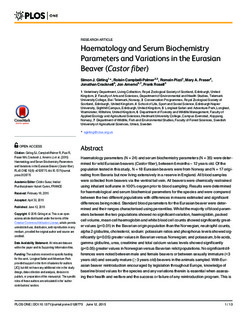Haematology and Serum Biochemistry Parameters and Variations in the Eurasian Beaver (Castor fiber)
Girling, Simon J.; Campbell-Palmer, Roisin; Pizzi, Romain; Fraser, Mary A.; Cracknell, Jonathan; Arnemo, Jon Martin; Rosell, Frank
Journal article, Peer reviewed
Permanent lenke
http://hdl.handle.net/11250/285069Utgivelsesdato
2015Metadata
Vis full innførselSamlinger
Originalversjon
Girling, S., Campbell-Palmer, R., Pizzi, R., Fraser, M. A., Cracknell, J., Arnemo, J. M., & Rosell, F. (2015). Haematology and Serum Biochemistry Parameters and Variations in the Eurasian Beaver (Castor fiber). PLoS ONE, 10(6). doi: 10.1371/journal.pone.0128775 10.1371/journal.pone.0128775Sammendrag
Haematology parameters (N = 24) and serum biochemistry parameters (N = 35) were determined for wild Eurasian beavers (Castor fiber), between 6 months – 12 years old. Of the population tested in this study, N = 18 Eurasian beavers were from Norway and N = 17 originating from Bavaria but now living extensively in a reserve in England. All blood samples were collected from beavers via the ventral tail vein. All beavers were chemically restrained using inhalant isoflurane in 100% oxygen prior to blood sampling. Results were determined for haematological and serum biochemical parameters for the species and were compared between the two different populations with differences in means estimated and significant differences being noted. Standard blood parameters for the Eurasian beaver were determined and their ranges characterised using percentiles. Whilst the majority of blood parameters between the two populations showed no significant variation, haemoglobin, packed cell volume, mean cell haemoglobin and white blood cell counts showed significantly greater values (p<0.01) in the Bavarian origin population than the Norwegian; neutrophil counts, alpha 2 globulins, cholesterol, sodium: potassium ratios and phosphorus levels showed significantly (p<0.05) greater values in Bavarian versus Norwegian; and potassium, bile acids, gamma globulins, urea, creatinine and total calcium values levels showed significantly (p<0.05) greater values in Norwegian versus Bavarian relict populations. No significant differences were noted between male and female beavers or between sexually immature (<3 years old) and sexually mature (≥3 years old) beavers in the animals sampled. With Eurasian beaver reintroduction encouraged by legislation throughout Europe, knowledge of baseline blood values for the species and any variations therein is essential when assessing their health and welfare and the success or failure of any reintroduction program. This is the first study to produce base-line blood values and their variations for the Eurasian beaver.
